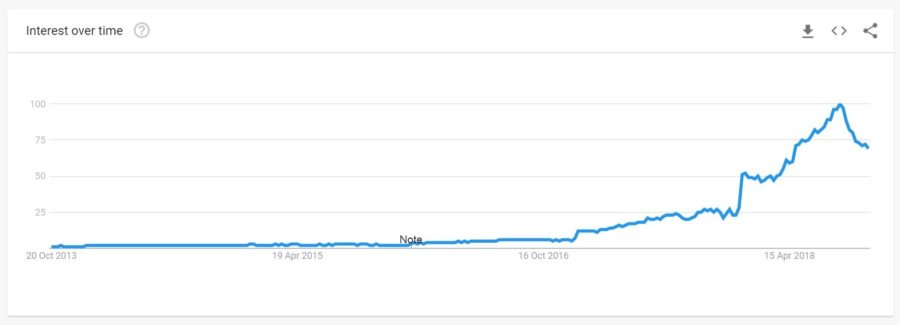
What the FLIK is…the Ketogenic Diet?
The ketogenic diet is an extremely low carbohydrate, moderate protein, and high fat diet that starting in the 1920s as a treatment for epilepsy. Within the last few years, however the diet has made a resurgence and become increasingly popular, with claims for reversing type 2 diabetes, promoting lasting weight loss, and even improving sports performance. A simple Google search shows how the search for ‘keto’ has increased over the last five years.

Where did this trend start?
Well, it first popped up in the professional sports world as a plan that would help athletes work harder for longer by burning fat for fuel. This quickly turned mainstream and the diet has had an extra boost from celebrities like Halle Berry and Kourtney Kardashian who’ve been quoted as proponents of the low carbohydrate eating plan. The market has responded to the trend with a boom in product sales touted as ‘keto-friendly’ which is making it clear that this diet isn’t going anywhere anytime soon. But, before you pour another cup of butter-loaded coffee, listen-up: The research on this diet is mixed with many studies lasting only a short period of time making it difficult to recommend a high fat eating plan over the long term.
What the FLIK is the Keto diet?
Most ketogenic diet plans recommend a carbohydrate intake between 30 and 50 grams per day. To put this into perspective, one standard slice of whole wheat bread has about 15 grams of carbohydrates. The average diet is between 50-60 percent of total calories from carbohydrate which equates to about 250 to 300 grams on a 2000 calorie per day diet. The ketogenic diet also requires a moderate intake of protein leaving fat as the primary macronutrient for consumption on a ketogenic diet at about 70-80 percent of total calories.
Why ‘Keto’?
The term ketogenic refers to the production of ketones, a result of fat converted to energy. These compounds are produced in the absence of adequate glucose, the body’s primary energy source. This adaptation is a survival mechanism to ensure that the body has enough energy to maintain bodily functions, including providing energy to the brain. Another result of the development of ketones is the reduction of insulin levels since glucose is unavailable. The production of ketones results in the body entering a state called “ketosis.”
What Foods Are Allowed?
The ketogenic diet places an emphasis on high fat foods from a variety of sources. Both saturated and unsaturated fat sources are allowed, but variations on the diet interpret the amounts from the various fat sources differently. This means foods like butter, oils, lard, plant-based fats, avocado, and nuts are emphasized on this plan. Carbohydrate sources are limited, but can include non-starchy vegetables, some fruits like berries, and some dairy products. Protein sources include beef, poultry, fish, pork, and eggs among other, low-carbohydrate plant-based sources of protein.
Should You Go ‘Keto’?
Short-term studies in the overweight and obese population have shown positive effects on health when following a ketogenic diet. Many on the ketogenic diet experience weight loss and show improvements in insulin resistance, lipid panels, and blood pressure. However, the short-term nature of the studies makes it challenging to recommend this type of diet for the long-term. It’s also worth noting that long-term studies on diet interventions like low-fat or low-carbohydrate diets, not specifically ketogenic diets, show similar results as a ketogenic diet when it comes to metabolic outcomes. This points to the conclusion that many diets can work for long-term weight maintenance and there might not be a single most effective diet for everyone. It’s also worth noting that the high-fat intake of the ketogenic diet contradicts the research that shows people who consume excess amounts of dietary fat, specifically saturated fat, are more likely to experience chronic health conditions such as heart disease and some cancers.

While it’s possible to follow a ketogenic diet that doesn’t solely focus on saturated fat sources and incorporates monounsaturated and polyunsaturated fats as well, special attention must be paid to the source of dietary fats in this eating plan to achieve a balanced intake. The elimination of certain carbohydrate sources, such as beans and whole grains, is also contradictory to population health studies that show a connection between whole grain, bean, and whole fruit intake and long-term, positive health outcomes such as a lower risk for colorectal cancer and heart disease. Lastly, following a ketogenic diet can have some negative side effects such as constipation, bad breath, and general fatigue.
So, before you jump to following a ketogenic diet, know that there is much to consider before starting this type of diet. Ask yourself if you plan to follow the diet for a short time to lose weight or if you would like to follow it over the long term. If it is only for a short amount of time, then what is the plan after you stop the diet? Consider that it might be possible, and even more enjoyable and sustainable, to achieve similar results on a modified eating plan under the guidance of a registered dietitian.
+++
Interested in more trending topics in the food and wellness worlds? Be sure to check out our other What the FLIK... columns like:
+++
For more information about FLIK Hospitality and the FLIK Blog, please e-mail us at flikblog@compass-usa.com.